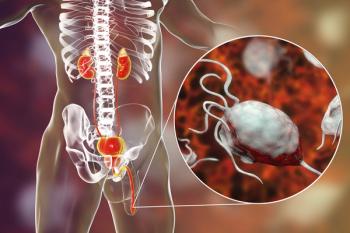
Oncology NEWS International
- Oncology NEWS International Vol 4 No 2
- Volume 4
- Issue 2
Finasteride Studied as Prostate Ca Preventive
NEW YORK--Finasteride (Pros-car), currently FDA approved for use in patients with symptomatic benign prostatic hyperplasia (BPH), is also being investigated as a prostate cancer treatment and is showing promise as an agent to prevent prostate cancer by reducing levels of dihydrotestosterone (DHT), Glenn J. Gormley, MD, PhD, said at the first International Conference on Cancer Prevention.
NEW YORK--Finasteride (Pros-car), currently FDA approved for usein patients with symptomatic benign prostatic hyperplasia (BPH),is also being investigated as a prostate cancer treatment andis showing promise as an agent to prevent prostate cancer by reducinglevels of dihydrotestosterone (DHT), Glenn J. Gormley, MD, PhD,said at the first International Conference on Cancer Prevention.
The program was sponsored by Strang Cancer Prevention Center,Cornell University Medical College, and the European School ofOncology.
Dr. Gormley, senior director of clinical research, endocrinologyand metabolism, Merck Research Laboratories, was one of the keyindividuals involved in the introduction of the compound.
He told the audience that a combined National Cancer Instituteand Southwest Oncology Group clinical trial is now underway toassess the efficacy and safety of finasteride as a prostate cancerpreventive. It will be given over a period of about 7 years tosome 18,000 men aged 55 to 70 years who have no existing prostatecancer.
Finasteride inhibits 5-alpha-reductase, thereby blocking the conversionof testosterone to the more potent androgen DHT, Dr. Gormley said."DHT has five to 10 times the affinity for the androgen receptor."He also stressed that "with the 5-alpha-reductase inhibitors,you can remove DHT-mediated functions without interfering withtestosterone-mediated ing functions of the body."
This is a very important point in understanding the safety profileof finasteride and how it differs from that of the antiandrogens,which block the binding of all androgens within the cells andproduce more of the "castration-like" effect, he said.
No Effect on Other Hormones
In a review of his own work and that of other investigators overseveral years concerning the potential toxicity of finasteride,Dr. Gormley concluded that "from a hormonal perspective,we see no effect on cortisol, estradiol, androstenedione, prolactin,thyroxine, LH, FSH, or any other hormonal parameters that we evaluated."He also said that in these studies of the agent, no effects onhematology, electrolytes, glucose, or liver function tests havebeen found.
Normally, serum levels show testosterone to be the major circulatingandrogen and DHT a very minor component, but within the prostate,the opposite ratio normally exists, he said. The difference stemsfrom the normally high level of 5-alpha-reductase within the prostate,so that any testosterone that reaches the gland is converted toDHT.
Dr. Gormley summarized a study, reported by Geller in the Journalof Cellular Biochemistry in 1992, that compared hormone levelsin the prostates of prostate cancer patients who had been surgicallycastrated or treated with finasteride. In the men given finasteride,there was a dramatic drop in DHT levels in the prostate with anincrease in testosterone due to the enzyme block.
After surgical castration, both testosterone and DHT levels dropped,but the drop in DHT "did not go to zero as one might think,"Dr. Gormley said. "In fact, it may be less of a drop thanwith finasteride." This is because the testicle is not theonly source of androgen in the body. "The adrenal gland stillmakes a substantial amount of androgen, which can get to the prostateand be converted into DHT in the absence of inhibitors."
Dr. Gormley reported that when men with BPH were started on finasteride,5 mg/day, there was a dramatic drop in serum DHT levels. Thiswas maintained for a period of 3 to 4 years without any casesof tachyphylaxis, he said. In contrast, there was very littleeffect seen on testosterone during this period.
In this trial, there was "clear regression of noncanceroushyperplastic prostate gland," Dr. Gormley said. In more than200 patients, prostate volume was reduced by about 20% in thefirst 6 months and close to 25% in the first year.
This volume reduction "occurs mainly at the epithelial componentrather than the stromal component of the gland . . . ie, the componentwhich undergoes both atrophy and decrease in cell number,"he said.
He then pointed to several animal studies that showed reductionin tumor growth with various forms of androgen deprivation. Inhuman cell lines studied by Italian researchers, there was a "cleardose-response suppression of tumor growth in cells" withfinasteride.
Finally, Dr. Gormley described a short-term pilot study of about28 men at Memorial Sloan-Kettering Cancer Center that looked atmarkers of prostate cancer cell growth, including PSA. The studysubjects received 10 mg/day of finasteride for up to 24 weeks.Serum PSA levels were reduced by about 20% in the first 3 weeks,and by about 30% by the end of the study.
Articles in this issue
almost 31 years ago
FTC Advised to List Tar and Nicotine Levels Directly on Cigarette Packagesalmost 31 years ago
Multidisciplinary Approach Urged For Pain Reliefalmost 31 years ago
FDA Approves New Indication for Neupogen: Chronic Neutropeniaalmost 31 years ago
Department of Labor Wants to Study Possible Occupation-Cancer Linksalmost 31 years ago
Navelbine Is Now Available for Use in Inoperable Advanced Stage NSCLCalmost 31 years ago
ASH Panel: How Many Hemotologists/Oncologists Are Enough?almost 31 years ago
Mammography Van Brings Breast Cancer Screening to the Workplacealmost 31 years ago
FDA to Build $600 Million Campusalmost 31 years ago
Panel Fails to Recommend Taxotere as Treatment for Breast and Lung CancerNewsletter
Stay up to date on recent advances in the multidisciplinary approach to cancer.

















































































